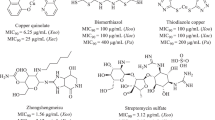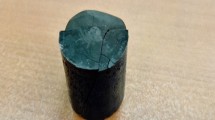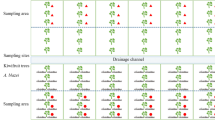Abstract
Agrocin 108 is a 3′-O-β-D-xylopyranosyl-cytidine-5′-O-phosphodiester of an ascorbate-carbocyclic cyclopentenone analogue, with bacteriocin-like properties. This bacteriocin exhibits orders of magnitude greater than the inhibition zone diameter towards the indicator strain than either ampicillin or streptomycin. It has been isolated from cultures of Rhizobium rhizogenes strain K108. The structure of the agrocin 108 without detail, has been previously published. We now report a detailed structure elucidation, including the hitherto undetermined residual 5′-phospho-diester fragment by a combination of 1D and 2D NMR studies at various pH values in H2O/D2O, high resolution MS, pKa determination, and chemical degradation.
Similar content being viewed by others
Log in or create a free account to read this content
Gain free access to this article, as well as selected content from this journal and more on nature.com
or
References
Kerr A. Biological control of crown gall. Australas Plant Pathol. 2016;45:15–8.
Kerr A, Htay K. Biological control of crown gall through bacteriocin production. Physiol Plant Path. 1974;4:37–44.
Tate ME, Murphy PJ, Roberts WP, Kerr A. Adenine N 6-substituent of agrocin 84 determines its bacteriocin-like specificity. Nature. 1979;280:697–9.
El Sahili A, et al. A pyranose-2-phosphate motif is responsible for both antibiotic import and quorum-sensing regulation in Agrobacterium tumefaciens. PLoS Pathog. 2015;11:e1005071.
Clare BG. Agrocins. In: Vining LC, Stuttard C, editors. Genetics and Biochemistry of Antibiotic Production. Reading, Mass., USA: Butterworth-Heinemann, Biotechnology; 1995. Vol. 28, pp. 619–32
Stonier T. Agrobacterium tumefaciens Conn. II. Production of an antibiotic substance. J Bacteriol. 1960;79:889–98.
Liljegren DR, Tate ME. Spontaneous oscillations in the oxidative degradation of 2,4,6/3,5-pentahydroxycyclohexanone (scyllo-inosose). Carbohydr Res. 1980;82:378–84.
MestReNova, version 10.0.2-15465, Mestrelab Research, Santiago, Spain. 2015.
Tate ME. Determination of ionization constants by paper electrophoresis. Biochem J. 1981;195:419–26.
Trevelyan WE, Procter DP, Harrison JS. Detection of sugars on paper chromatograms. Nature. 1950;166:444–5.
Harrap FEG. The detection of phosphate esters on paper chromatograms. Analyst. 1960;85:452.
Veiga LA, Chandelier EL. Detection and differentiation of sugars on paper by the p-anisidine/periodate reaction. Anal Biochem. 1967;20:419–22.
Asenstorfer RE, Iland PG, Tate ME, Jones GP. Charge equilibria and pKa of malvidin-3-glucoside by electrophoresis. Anal Biochem. 2003;318:291–9.
WinCurveFit, version 1. 1.6, Kevin Raner Software, Mt Waverley, Victoria, Australia. 2001.
Hanahan DJ, Olley JN. Chemical nature of monophosphoinositides. J Biol Chem. 1958;231:813–28.
ChemDraw3D, version 14.0.0.117, CambridgeSoft Corporation, Perkin Elmer Inc. Waltham, Massachusetts, United States. 2014.
Donner, SC Agrocins from Agrobacteria. PhD thesis, The University of Adelaide, Australia. 1997. http://hdl.handle.net/2440/18932.
Luo P, et al. Crystal structure of a phosphorylation-coupled vitamin C transporter. Nat Struct Mol Biol. 2015;22:238–41.
Campos E, et al. The yiaKLX1X2PQRS and ulaABCDEFG gene systems are required for the aerobic utilization of L-ascorbate in Klebsiella pneumoniae strain 13882 with L-ascorbate-6-phosphate as the inducer. J Bacteriol. 2008;190:6615–24.
Murphy PJ, Tate ME, Kerr A. Substituents at N6 and C‐5′ control selective uptake and toxicity of the adenine‐nucleotide bacteriocin, agrocin 84, in agrobacteria. FEBS J. 1981;115:539–43.
Kerr A, Tate ME. Agrocins and the biological control of crown gall. Microbiol Sci. 1984;1:1–4.
Acknowledgements
The authors thank Professor Allen Kerr for the bacterial strains and extensive discussions. Philip Clements is thanked for providing the 600 MHz NMR data and Mark Solomon for the high resolution electrospray mass spectrometry data. The former support of Australian Research Council and latter the University of Adelaide Alumni Association is gratefully acknowledged. This paper is dedicated to the memory of Max E. Tate (deceased 2016).
Author contributions
CE and the late MET performed the original 1979 investigation, intermittent studies by SD and the late MET culminated in 2016, when sufficient spectroscopic data were accumulated with the help of RA, for a rational complete structure. MR provided recent microbiological activity information and GPJ assisted in the interpretation of the NMR data. The late MET, RA, and GPJ prepared the manuscript.
Author information
Authors and Affiliations
Corresponding author
Ethics declarations
Conflict of interest
The authors declare that they have no conflict of interest.
Additional information
Publisher's note: Springer Nature remains neutral with regard to jurisdictional claims in published maps and institutional affiliations.
Electronic supplementary material
Rights and permissions
About this article
Cite this article
Elvin, C.M., Asenstorfer, R.E., Ryder, M.H. et al. Agrocin 108 is a 5'-cytidine nucleotide bacteriocin containing a carbocyclic phosphoryl-ascorbate group. J Antibiot 71, 438–446 (2018). https://doi.org/10.1038/s41429-017-0014-y
Received:
Revised:
Accepted:
Published:
Issue date:
DOI: https://doi.org/10.1038/s41429-017-0014-y



